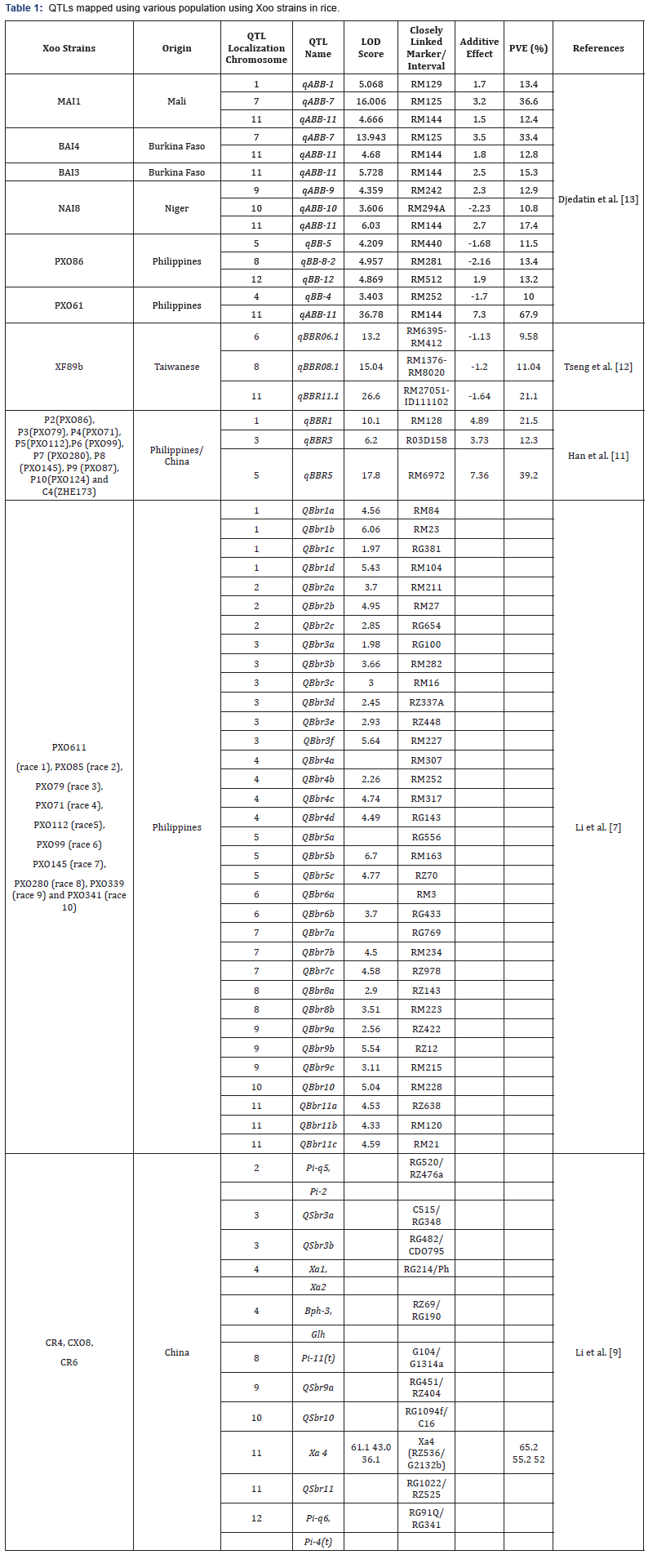Bacterial Blight Quantitative Resistance in Rice (Oryza sativa L.)
Lincoln Mandal1*, Sunil Kumar Verma2, Saugata Sasmal3 and Jawahar lal Katara4
1 Department of Agriculture and Biotechnology, CG, India
2 Department of Genetics and Plant Breeding, CARS, India
3 Krishi Vigyan Kendra, IGKV, India
4 Department of Plant Biotechnology, National Rice Research Institute, India
Submission: November 30, 2017; Published: February 27, 2018
*Corresponding author: Lincoln Mandal, Department of Agriculture and Biotechnology, CG, Raipur-492012, India.
How to cite this article: Lincoln M, Sunil K V, Saugata S, Jawahar l K. Bacterial Blight Quantitative Resistance in Rice (Oryza sativa L.). Adv Biotech & Micro. 2018; 8(3): 555738. DOI: 10.19080/AIBM.2018.08.555738
Abstract
Bacterial blight disease, caused by Xanthomonas oryzae pv. oryzae (Xoo), is one of the most serious diseases in rice producing areas. The durable and broad resistance of plants was found to be usually governed by multiple genes or quantitative trait loci (QTLs). The quantitative trait loci were mapped for bacterial blight resistance in rice by various researchers almost on all chromosomes. QTLs mapped will facilitate the isolation of novel Bacterial blight resistance genes and their utilization in rice resistance breeding through marker-assisted selection.
Introduction
The Bacterial leaf blight caused by Xanthomonas oryzae pv. oryzae (Xoo) [1,2] is one of the most destructive diseases of rice throughout the world [3]. The presence of complete resistance and partial resistance to Xanthomonas oryzae pv. oryzae in rice has been reported [4,5]. The resistance of rice to specific Xanthomonas oryzae pv. oryzae races is governed by both major R genes with a qualitative effect that condition complete resistance (CR) and polygenes with a quantitative effect (quantitative trait loci, QTL) that condition partial resistance (PR) [6,7]. The durable and broad resistance of plants was found to be usually governed by multiple genes or quantitative trait loci (QTLs) [8].
Quantitative Trait Loci
The Quantitative Trait Loci were mapped for bacterial blight resistance in rice by many researchers using various mapping population [7,9-13] shown in Table 1.

Importance
The QTLs mapped will facilitate the isolation of novel Bacterial blight resistance genes and their utilization in rice resistance breeding [11]. The new information on genes and QTLs for resistance to bacterial blight will be useful for controlling the disease [13]. The molecular mapping of QTL results provide a suitable source of potential disease resistance genes and establish a system for improving rice bacterial blight resistance through marker-assisted selection [12]. The race specificity of partial resistance (PR) and its strong genetic overlap with complete resistance (CR) indicate that partial resistance (PR) is essentially ‘‘weaker’’ complete resistance (CR) [7]. A high level of durable resistance to Xoo may be achieved by the cumulative effects of multiple QTLs, including the residual effects of ``defeated’’ major resistance genes [9].
References
- Ishiyama S (1922) Studies on bacterial blight of rice. Report of Agric Exp Station 45: 233-261.
- Swings J, Van Den Mooter M, Vauterin L, Hoste B, Gillis M, et al. (1990) Reclassification of the causal agents of bacterial blight Xanthomonas campestris pv. oryzae and bacterial leaf streak Xanthomonas campestris pv. oryzicola of rice as pathovars of Xanthomonas oryzae new species Ex Ishiyama 1922. Int J Syst Bacteriol 40: 309-311.
- Mew TW (1987) Current status and future prospects of research on bacterial blight of rice. Annu Rev Phytopathol 25: 359-382.
- Zhang Q, Mew TW (1985) Adult plant resistance of rice cultivars to bacterial blight. Plant Dis 69: 896-898.
- Parlevliet JE, Zadoks JC (1977) Integrated concept of disease resistance-new view including horizontal and vertical resistance in plants. Euphytica 26(1): 5-21.
- Koch MF, Parlevliet JE (1991) Genetic analysis of, and selection for, factors affecting quantitative resistance to Xanthomonas campestris pv. oryzae in rice. Euphytica 53(3): 235-245.
- Li ZK, Arif M, Zhong DB, Fu BY, Xu JL, et al. (2006) Complex genetic networks underlying the defensive system of rice (Oryza sativa L.) to Xanthomonas oryzae pv. oryzae. Proc Nat Acad Sci USA 103(21): 7994- 7999.
- Johnson R (1984) A critical analysis of durable resistance. Annu Rev Phytopathol 22: 309-330
- Li ZK, Luo LJ, Mei HW, Paterson AH, Zhong DB, et al. (1999) A ‘defeated’ rice resistance gene acts as a QTL against a virulent strain of Xanthomonas oryzae pv. oryzae. Mol Gen Genet 261: 58-63.
- Sujatha K, Natarajkumar P, Laha GS, Mishra B, Rao KS, et al. (2011) Inheritance of bacterial blight resistance in the rice cultivar Ajaya and high-resolution mapping of a major QTL associated with resistance. Genet Res Camb 93(6): 397-408.
- Han X, Yang Y, Wang X, Zhou J, Zhang W, et al. (2014) Quantitative trait loci mapping for bacterial blight resistance in rice using bulked segregant analysis. Int J Mol Sci 15(7): 11847-11861.
- Tseng HY, Lin DG, Hsieh HY, Tseng YJ, Tseng WB, et al. (2015) Genetic analysis and molecular mapping of QTLs associated with resistance to bacterial blight in a rice mutant, SA042. Euphytica 205(1): 231-241.
- Djedatin G, Ndjiondjop MN, Sanni A, Lorieux M, Verdier V, et al. (2016) Identification of novel major and minor QTLs associated with Xanthomonas oryzae pv. oryzae (African strains) resistance in rice (Oryza sativa L.). Rice 9: 18.






























